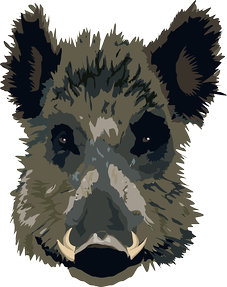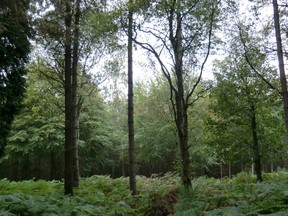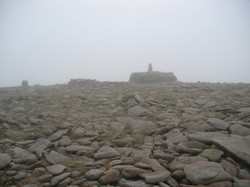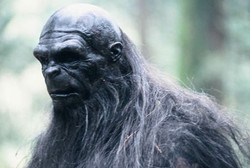 Wild boar was once sought in Cannock Chase, until the Medieval huntsmen wiped them all out of existence. It's been theorized that Pig-Man could be a sighting of a survivor, whose ancestors have kept themselves safely entrenched in the forest depths.
Wild boar was once sought in Cannock Chase, until the Medieval huntsmen wiped them all out of existence. It's been theorized that Pig-Man could be a sighting of a survivor, whose ancestors have kept themselves safely entrenched in the forest depths.
But how does that explain the human clothing?
There's a local tradition about werewolves prowling the Chase at full moon. Could the Pig-Man be some kind of porcine cousin? A human being, who turns into a swine instead?
Yet more have pointed out that the military have used (and still use) Cannock Chase for all manner of manoeuvrings. Ruins of Prisoner of War camps, and the attendant German cemeteries, line glades in that forest, not to mention the Barracks Museum up Marquess Drive. Unwary wanderers have heard the shots of the modern army in training amidst the ferns and other foliage.
(And I can personally testify to that, having been surprised by rapid gunfire around midnight up Castle Ring. I don't think my friends and I have ever run so fast, as back to our car that night!)
So what if something more occurred within those bunkers? Experiments perchance, amongst the chemical weapons and other accoutrements of warfare? Is that how Pig-Man came into existence?
Or merely a military scare story designed to keep the children away?


 Pick any of the old mining towns around Cannock Chase, go back to the 1940s, and you'll hear the children singing a skipping song:
Pick any of the old mining towns around Cannock Chase, go back to the 1940s, and you'll hear the children singing a skipping song:
 Wild boar was once sought in Cannock Chase, until the Medieval huntsmen wiped them all out of existence. It's been theorized that Pig-Man could be a sighting of a survivor, whose ancestors have kept themselves safely entrenched in the forest depths.
Wild boar was once sought in Cannock Chase, until the Medieval huntsmen wiped them all out of existence. It's been theorized that Pig-Man could be a sighting of a survivor, whose ancestors have kept themselves safely entrenched in the forest depths.

 St Tydecho's Churches in West Waleson 09/03/2014
St Tydecho's Churches in West Waleson 09/03/2014
 Goodies for an Outlander Premiere Partyon 03/06/2015
Goodies for an Outlander Premiere Partyon 03/06/2015
 Holocaust Memorial Day Interview with Rainer Höss, Grandson of Rudolf Architect of Auschwitzon 01/24/2015
Holocaust Memorial Day Interview with Rainer Höss, Grandson of Rudolf Architect of Auschwitzon 01/24/2015
 Romantic Valentine Gifts for an Outlander Fanon 01/16/2015
Romantic Valentine Gifts for an Outlander Fanon 01/16/2015




Comments
Hi Lee, Thank you very much for stopping by, and for your lovely offer. I've got your book on my wish list for Christmas, but I don't know if I'll wait that long to get it! :)
Hi guys, I actually wrote this book and I'm so glad it has resulted in such a long and thorough conversation! Just thought I'd stop by and let you all know that I'm free and willing to answer any questions you might have about the Legend of the Pig-man in Cannock Chase ;)
I have had some moments of lovely pareidolia in the Chase. Then there was the time when I looked, assumed pareidolia, then the thing moved. It turned out to be a stag, not far away.
Ordinarily, I'd be nodding in agreement with your ancient Pagan theory. But there's no evidence that this legend dates back before the 1940s, when there was a lot of WWII activity up there. Maybe it was easier to imagine a Pig-Man squealing in the woods, than to acknowledge the POW camp and the ever growing German cemetery.
I love the boar crest theory. This was Mercian territory around here. We're about 20 mins - half an hour away from Offa's Dyke. Before that, this was Powys. For the indigenous Celts, the Mercians coming through would certainly have seemed like bogeyman.
Legends often have several roots, streams that flow together to make them. Another thought struck me. The Anglo-Saxon earls would have an official called a hog guard, the pig warden, to protect their large herds of pigs. Pigs would have been herded on the woodland of Cannock Chase, and there would have been a hog guard. A particularly nasty hog guard may have contributed to the legend. He was the pigman. When someone particularly nasty dies, some people fear his roaming spirit. Just as Alexander the Great is a bogeyman to Indian children 2300 years after his death, the pig man might have become a bogeyman in the Cannock Chase area.
I have just done some research. Anglo-Saxon warriors often used boar crest helmets, as the boar was a magical animal. Could this be a contribution to the legend?
There is the problem that when an object is fleetingly seen, the mind joins up the dots and imposes a pattern on it, which will be drawn from the brain's stock of visual images. I suspect that this is what is happening with pigman sightings, which occur after dark has fallen. People see the pigman because they expect to see it.
Behind the pigman is, I suspect, a legend that goes back to ancient times. A shaman often wore an animal mask, as we can see from pictures in ancient caves. It was also the case that paganism did not die out when Christianity arrived, and people carried on their old rituals. A shaman in a pig's mask may well have performed rituals, and this could have gone on well into the middle ages. Thus the memory of the pigman lurked in popular consciousness. He is now a kind of bogeyman.
As for squeals, pigs are woodland creatures adept at hiding among the trees. Pigs that have got loose in woods are almost uncatchable. There coukd well be a feral pig population in the area, and this would have been reinforced by wild boar, that are now spreading
John - It's an old mining area. The region is full of closed pits and ex-miners. But plenty of room to hide a secret research facility, especially hidden in an old coal shaft. Ooooh! The plot thickens!
Frank - I think that the main thing is that it's been woodland since the Ice Age. The Cornovii had their hill forts up there, the Mercians hunted there, the Normans built castles on the outskirts (well, one castle), and it's continued to be a forest ever since. That's a lot of time for things to happen. Plus it's where the POW camps were during the Second World War. The German cemetery is quite big, which tells us a lot about conditions in those camps.
And, indeed, there are a lot of pubs.
Rupert - Some cropped up in Animal Farm. It was hard to tell the difference between them and the humans...
Just did some searches on Cannock Chase. Seems to be a lot of jobs for lab technicians there. But no real labs... Just a hospital... Maybe the pigman escaped from a secret research facility nearby??